I remember first seeing this image while scrolling through the Magnum website at the beginning of the semester. It instantly struck me, for multiple reasons. First, as I have written many times, I am very drawn to cinematic, filmic images. The rich colors, shallow depth of field, and relatively low contrast makes this photo look like it could be a still from a movie. I can imagine the story of a father leaving his young wife and child in a taxi to go off on a quest of some sort. And I can also image that McCurry experienced a similar situation; he was in a car, maybe a taxi, and and this woman and her child in some way desired to be inside with him
But regardless of the actual details of the story behind the photo, the photo speaks for itself, with the both physical as well as more metaphorical separation and yearning that it depicts. McCurry, and his camera, were able to look out from the comfort of the inside of the car. Outside, the woman and her child stand in the rain, separated from the the inside by the glass of the window. In the same way, these possibly lower socioeconomic Indian citizens are separated from McCurry, a relatively wealthy white man, by both a physical piece of glass, but also a social and economic divide.
The two subjects of the photo are hauntingly beautiful, and McCurry expertly captures their looks as well as their emotions. I am reminded of probably McCurry’s most famous photo, the portrait of an Afghan girl with striking green eyes.
I greatly enjoy both of these photos, but in a way, both seem to delve into the realm of what some photographers refer to as poverty porn; images that beautifully capture impoverished peoples, yet are devoid of any true meaning or understanding of the people’s actual lives.
Where McCurry was able to capture sorrow and yearning in the photo I described above, he was able to capture joy and devotion to tradition in this one. The man in the middle, covered from head to toe in green powder, is completely at peace, overjoyed and overwhelmed by emotion, as he participates in the Hindu celebration of color, Holi. Everyone in the photo is simultaneously extremely serious and extremely lighthearted; they are passionate about the events they are taking part in, yet at the same time, they are all having a really good time. They are devoted to this tradition, in the best possible way.
Upon first glance, this photo is somewhat abstract. The whole photo appears to be a mass of red, with a strip of green in the middle. Shot from above, the red turbans of the men appear as just round red blobs. Closer inspection might deceive the viewer into thinking the photo was altered in Photoshop; all of the men around the edges of the photo are completely red, while the man in the center is completely green.
This photo provides a stark contrast to the one above. Where the image of the mother and daughter outside the car window might have showed the hardships and separation of a foreign culture. This photo of the colorful men does the opposite; it shows a group of foreign people that are extremely happy and rich in tradition.
It is interesting to compare McCurry’s photos in India to the work of Martin Parr, specifically his Reporters Without Boarders series.
Of course, the most obvious difference between the two groups of photos are the actual photographic styles. McCurry employs, as I mentioned above, a much more film-like style; the contrast is relatively low, and the blacks are slightly crushed. He uses natural (or what is made to look like natural) lighting. The colors of his photos are rich, but not overly saturated, with a tendency towards a focus on the red and greens in the images. For the most part, he goes for very classical compositions, almost never completely centering his subjects.
It is hard to actually express this notion in words, but McCurry takes what could be describes as highly “professional,” artful images. They look like they were taken with expensive equipment, by a highly skilled photographer. In contrast, Parr embraces a lo-fi, cheap camera aesthetic.
He shoots with a flash, making his subjects very bright. Because of the flash, objects in the frame cast harsh shadows. Parr’s photos have much higher contrast and saturation, and just look much more stylistically “cheap.” He also uses stylistically wrong composition, centering his subjects. But this intentional; it creates a feeling of discomfort or uneasiness in his work.
But despite these differences, both photographers are doing similar work in their series. Both have gone to a relatively unique cultures, and just photographed the daily occurrences, in an attempt to get an overall mood for the location. Yet the other key difference between the two projects is their tone, and their treatments of the subject themselves. McCurry takes grand, cinematic shots, that seems to convey a sense of respect and awe for his subjects. Parr, on the other hand, is borderline making fun of his own subjects. He captures them in a sort grotesque, almost mean way, making the people he photographs into spectacles for others to look down upon.


Leave a Reply
You must be logged in to post a comment.